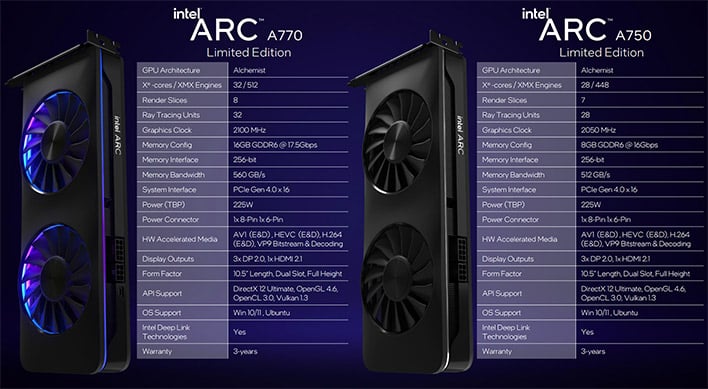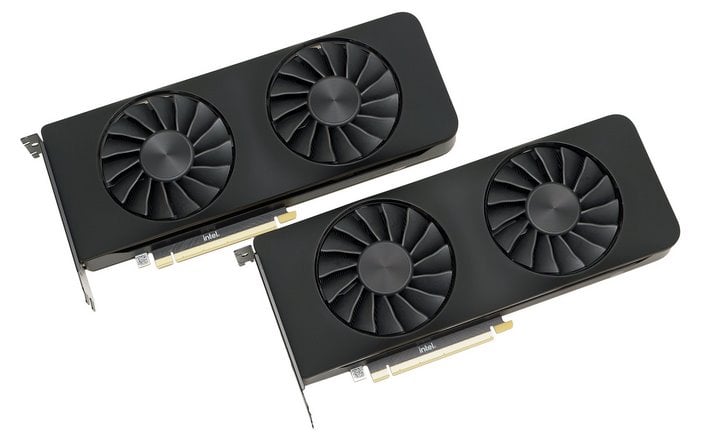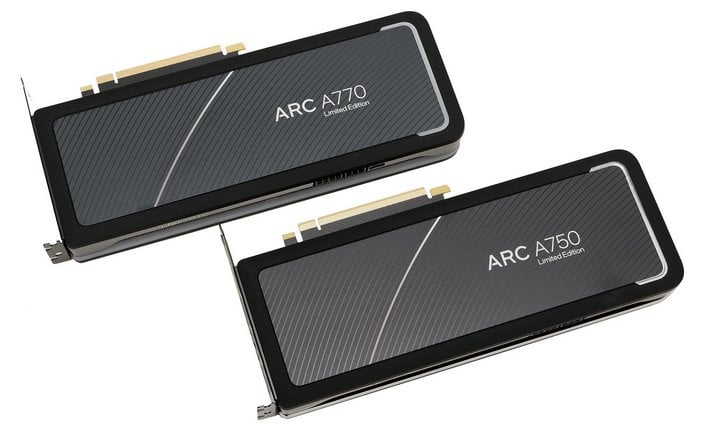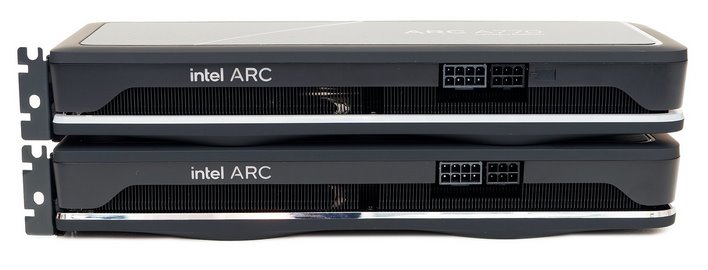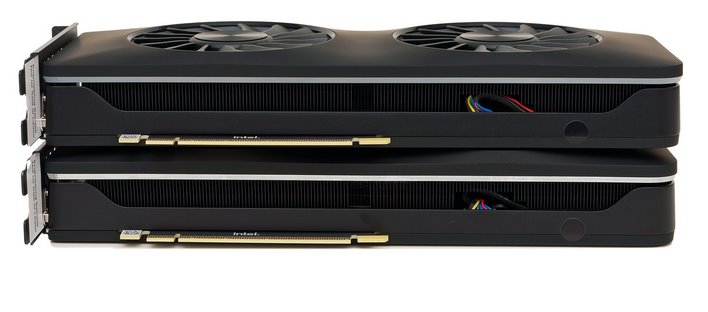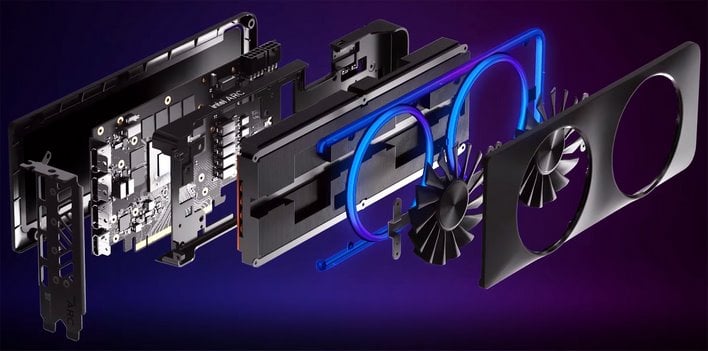Intel Arc A770 And A750 Limited Edition Review: Putting Alchemist To The Test
Arc A770 And A750 Limited Edition: Intel's First Real Gaming GPUs Finally Arrive For In-House Testing

| Intel Arc A750 And A770: Starting At $289 The highly anticipated Intel Arc A750 and A770 Limited Edition discrete GPUs have arrived, offering competitive performance and pricing.
|
|||

|

|
||
After years of teases, leaks and official disclosures, and a week before the cards are due to go on sale, we are finally ready and able to put Intel’s first discrete, desktop GPUs for gamers -- the Arc A750 and A770 Limited Editions -- to the test.
Of course, at this point, there’s probably not much you don’t already know about the cards. If you follow the GPU scene at all, you’ll be aware that Intel has disclosed just about all there is to know about the cards over the last few weeks, through a myriad of videos and blog posts hosted on Intel’s site and across various social media channels.
Despite Intel’s relative openness with this Arc Alchemist A-series launch, however, there are always some interesting revelations once cards are let loose into the wild. Although we’ve only had our cards in-hand for a short time, we’ve tried to put them through a wide array of tests, across gaming, content creation and compute workloads, to suss out any additional juicy tidbits that were perhaps not discovered in Intel’s disclosures thus far.
Let’s get started with a quick look at the Intel Arc A750 and A770 Limited Edition cards first, then we’ll re-cap some of the finer details regarding the underlying architecture before diving into the benchmarks. Strap in, because this is going to be a wild ride...
Intel Arc A750 & A770 Limited Edition Hands-On Video
Intel Arc A750 And A770 Limited Edition Features & Specifications
The Intel Arc A750 and A770 Limited Edition cards are both based on the ACM-G10 GPU. The ACM-G10 is manufactured at TSMC and has an approximate die size of 406mm2, which is relatively large for this segment. The GA106 used on the RTX 3060 is only 276mm2, for example, and the GA104 used on the 3060 Ti / 3070 is 392.5mm2.
In the Arc A770 Limited Edition, the ACM-G10 GPU is fully enabled, with all 8 render slices lit up, featuring 32 Xe cores, 32 Ray Tracing Units, 512 XMX Engines (for AI workloads), and 128 ROPs. The GPU is linked to 16GB of GDDR6 memory running at 17.5Gbps, over a 256-bit interface, for a peak of 560GB/s of memory bandwidth. There is also an 8GB A770 coming down the pipeline, with somewhat slower 16Gbps memory, similar to the A750. Speaking of the A750, its GPU is fundamentally similar to the A770’s, but it has one render slice disabled, which brings its Xe Core count down to 28, with 28 Ray Tracing Units, and 448 XMX Engines. It too has a 256-bit memory interface, but with only 8GB attached, running at the aforementioned 16Gbps, which equates to 512GB/s of peak bandwidth.
Both the Intel Arc A750 and A770 Limited Edition are 10.5” long, two slots wide, have 225W TDPs (Thermal Design Power), and require two supplemental power connections – one 8-pin and one 6-pin, though custom partner boards may have different connectors when they begin to arrive in the coming weeks. We'll cover more details regarding the media and display engines in Intel's new GPU, on the next page.
Inspecting The Intel Arc A750 And A770 Limited Editions
Although the cards look similar at first glance, the Arc A770 Limited Edition features 90 fully controllable RGB LEDs that run around the fan cut-outs and rim of the card. The overall design is very clean relative to many of today’s gaming-class GPUs. The cards feature a matte black, soft-touch finish, with stealth black IO brackets as well. First impressions when holding the card and inspecting it up close are very positive. Having reviewed hundreds, if not thousands of graphics cards over the years, we can say the build quality, fit and finish of the Arc A750 and A770 Limited Editions is right up there with some of the best. Despite their competitive pricing, the cards feel rather premium.The fan shroud on the front of the cards has some swoopy curves and contours – it’s not completely flat – with chamfered fan cut-outs, but no discerning features otherwise. The axial fans both feature 15 blades, and as you’ll see a little later, they provide plenty of air-flow to keep the cards running cool and relatively quiet, along with the beefy heatsink assembly underneath.
The backside of the cards have full-coverage backplates, also with a mostly matte-black, soft-touch finish. Curved grey lines and Intel’s signature “arc” adorn the center section, along with each card's branding, and a U-shaped accent at the rear. On the A750 that accent is glossy chrome, but on the A770 Limited Edition, the white trim actually houses some RGB LEDs.
The cards’ large heatsink and vapor chambers, and some of the multiple heat pipes (if you look closely) are visible from the top and bottom edges, along with parts of the die-cast aluminum frame that helps hold everything together and add some rigidity.
Although they look similar from the top and bottom when powered off, the A770 Limited Edition has a couple of key differences. For one, there's an additional connector (visible to the right of the dual power connectors), which is used to attach the card to an internal USB header, for control of the integrated RGB lighting. And the stripe the runs all the way around the cards is lighted on the A770 LE, though it's chrome on the A750. The “Intel Arc” branding on the top edge of both cards is lighted, however -- you just can't control it on the A750.
The PCB underneath all of that hardware is shorter than the fan shroud; it extends only about a half inch beyond the power connectors. This PCB houses a relatively paltry 6 VRM phases, though once again, partner boards may make some modifications in that regard. We’re hoping to have more details to share regarding custom partner boards soon.
Now that you’ve see the actual cards, let’s re-cap what makes them tick and run through some of the unique features offered by Intel Arc...

